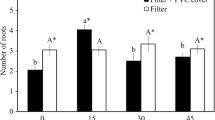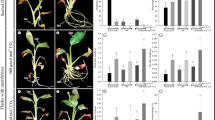Abstract
Carnation plantlets (Dianthus caryophyllus L.) cultured in vitro often develop morphological and physiological anomalies, a phenomenon called hyperhydricity, which impairs their survival ex vitro. When the agar concentration of the growth medium was increased (from 0 to 12 g dm−3), thereby reducing water availability, the hyperhydricity of those adventitious shoots regenerated from carnation petals decreased. This was accompanied by a progressive fall in the water content of shoots (94.9 to 91.4 %), fresh mass (from 57.2 to 1.8 mg), number of leaf parenchyma cell layers (from 9.3 to 7.7), and the size of these cells (from 968 to 254 µm2). However, the number of regenerated shoots also decreased (17.7 in 2 g dm−3 agar to 4.3 in 12 g dm−3). Similarly, in ventilated tubes, which exhibit a lower relative humidity than tightly closed tubes, shoot organogenesis diminished up to 28 %, in tandem with shoot water content. Thus, relative humidity and water availability in culture vessels do not only influence shoot hyperhydricity in carnations, but also greatly affect adventitious shoot organogenesis.
Similar content being viewed by others
Abbreviations
- DM:
-
dry matter
- FM:
-
fresh matter
- NAA:
-
1-naphthaleneacetic acid
- RH:
-
relative humidity
- TDZ:
-
thidiazuron (N-phenyl-N′-1,2,3-thiadiazol-5-ylurea)
References
Bornman, C.H., Vogelmann, T.C.: Effect of rigidity of gel medium on benzyladenine-induced adventitious bud formation and vitrification in vitro in Picea abies.-Physiol. Plant. 61: 505–512, 1984.
Casanova, E., Valdés, A.E., Fernández, B., Moysset, L., Trillas, M.I.: Levels and immunolocalization of endogenous cytokinins in thidiazuron-induced shoot organogenesis in carnation.-J. Plant Physiol. 161: 95–104, 2004.
Casanova, E., Zuker, A., Trillas, M.I., Moysset, L., Vainstein, A.: The rolC gene in carnation exhibits cytokinin-and auxin-like activities.-Sci. Hort. 97: 321–331, 2003.
Castro-Concha, L., Loyola-Vargas, V.M., Chan, J.L., Robert, M.L.: Glutamate dehydrogenase activity in normal and vitrified plants of Agave tequilana Weber propagated in vitro.-Plant Cell Tissue Organ Cult. 22: 147–151, 1990.
Debergh, P., Aitken-Christie, J., Cohen, D., Grout, B., Von Arnold, S., Zimmerman, R., Ziv, M.: Reconsideration of the term ‘vitrification’ as used in micropropagation.-Plant Cell Tissue Organ Cult. 30: 135–140, 1992.
Fisher, M., Ziv, M., Vainstein, A.: An efficient method for adventitious shoot regeneration from cultured carnation petals.-Sci. Hort. 53: 231–237, 1993.
Fujiwara, K., Kozai, T.: Physical microenvironment and its effects.-In: Aitken-Christie, J., Kozai, T., Smith, M.L. (ed.): Automation and Environmental Control in Plant Tissue Culture. Pp. 319–369. Kluwer Academic Publishers, Dordrecht 1995.
Genkov, T., Tsoneva, P., Ivanova, I.: Effect of cytokinins on photosynthetic pigments and chlorophyllase activity in in vitro cultures of axillary buds of Dianthus caryophyllus L.-J. Plant Growth Regul. 16: 169–172, 1997.
Gimelli, F., Ginatta, G., Venturo, R., Positano, S., Buiatti, M.: Plantlet regeneration from petals and floral induction in vitro in the Mediterranean carnation (Dianthus caryophyllus L.).-Riv. Ortoflorofrutt. It. 68: 107–121, 1984.
Jain, A., Kantia, A., Kothari, S.L.: De novo differentiation of shoot buds from leaf-callus of Dianthus caryophyllus L. and control of hyperhydricity.-Sci. Hort. 87: 319–326, 2001.
Kevers, C., Frank, T., Strasser, R.J., Dommes, J., Gaspar, T.: Hyperhydricity of micropropagated shoots: a typically stress-induced change of physiological state.-Plant Cell Tissue Organ Cult. 77: 181–191, 2004.
Kozai, T., Kitaya, Y., Fujiwara, K., Adelberg, J.: Environmental control for large scale production of in vitro plantlets.-In: Terzi, M., Cella, R., Falavigna, A. (ed.): Current Issues in Plant Molecular and Cellular Biology. Pp. 947–955. Kluwer Academic Publishers, Dordrecht 1995.
Lucchesini, M., Monteforti, G., Mensuali-Sodi, A., Serra, G.: Leaf ultrastructure, photosynthetic rate and growth of myrtle plantlets under different in vitro culture conditions.-Biol. Plant. 50: 161–168, 2006.
Majada, J.P., Fal, M.A., Sánchez-Tamés, R.: The effect of ventilation rate on proliferation and hyperhydricity of Dianthus caryophyllus L.-In Vitro cell. dev. Biol. 33: 62–69, 1997.
Majada, J.P., Sierra, M.I., Sánchez-Tamés, R.: Air exchange rate affects the in vitro developed leaf cuticle of carnation.-Sci. Hort. 87: 121–130, 2001.
Majada, J.P., Tadeo, F., Fal, M.A., Sánchez-Tamés, R.: Impact of culture vessel ventilation on the anatomy and morphology of micropropagated carnation.-Plant Cell Tissue Organ Cult. 63: 207–214, 2000.
Mii, M., Buiatti, M., Gimelli, F.: Carnation.-In: Ammirato, P.V., Evans, D.R., Sharp, W.R., Vajaj, Y.P.S. (ed.): Handbook of Plant Cell Culture. Pp. 284–318. McGraw-Hill, New York 1990.
Murashige, T., Skoog, F.: A revised medium for rapid growth and bioassays with tobacco tissue cultures.-Physiol. Plant. 15: 473–497, 1962.
Olmos, E., Hellín, E.: Ultrastructural differences of hyperhydric and normal leaves from regenerated carnation plants.-Sci. Hort. 75: 91–101, 1998.
Owens, L.D., Wozniak, C.A.: Measurement and effects of gel matric potential and expressibility on production of morphogenic callus by cultured sugar beet leaf discs.-Plant Cell Tissue Organ Cult. 26: 127–133, 1991.
Piqueras, A., Cortina, M., Serna, M.D., Casas, J.L.: Polyamines and hyperhydricity in micropropagated carnation plants.-Plant Sci. 162: 671–678, 2002.
Rady, M.R.: In vitro culture of Gypsophila paniculata L. and random amplified polymorphic DNA analysis of the propagated plants.-Biol. Plant. 50: 507–513, 2006.
Reynolds, E.S.: The use of lead citrate at high pH as an electron opaque stain in electron microscopy.-J. Cell Biol. 17: 208–212, 1963.
Saher, S., Piqueras, A., Hellín, E., Olmos, E.: Prevention of hyperhydricity in micropropagated carnation shoots by bottom cooling: implications of oxidative stress.-Plant Cell Tissue Organ Cult. 81: 149–158, 2005.
Sallanon, H., Maziere, Y.: Influence of growth room and vessel humidity on the in vitro development of rose plants.-Plant Cell Tissue Organ Cult. 30: 121–125, 1992.
Serret, M.D., Trillas, M.I., Matas, J., Araus, J.L.: The effect of different closure types, light, and sucrose concentrations on carbon isotope composition and growth of Gardenia jasminoides plantlets during micropropagation and subsequent acclimation ex vitro.-Plant Cell Tissue Organ Cult. 47: 217–230, 1997.
Smith, M.A.L., Spomer, L.A.: Vessels, gels, liquid media, and support systems.-In: Aitken-Christie, J., Kozai, T., Smith, M.L. (ed.): Automation and Environmental Control in Plant Tissue Culture. Pp. 371–404. Kluwer Academic Publishers, Dordrecht 1995.
Spurr, A.R.: A low viscosity epoxy resin embedding medium for electronmicroscopy.-J. Ultrasctruct. Res. 26: 31–43, 1969.
Turner, S.R., Singha, S.: Vitrification of crabapple, pear, and geum on gellan gum-solidified culture medium.-HortSci. 25: 1648–1650, 1990.
Vainstein, A. (ed.): Breeding For Ornamentals: Classical and Molecular Approaches.-Kluwer Academic Publishers, Dordrecht 2002.
Watad, A.A., Ahroni, A., Zuker, A., Shejtman, H., Nissim, A., Vainstein, A.: Adventitious shoot formation from carnation stem segments: a comparison of different culture procedures.-Sci. Hort. 65: 313–320, 1996.
Yadav, M.K., Gaur, A.K., Garg, G.K.: Development of suitable protocol to overcome hyperhydricity in carnation during micropropagation.-Plant Cell Tissue Organ Cult. 72: 153–156, 2003.
Ziv, M.: Vitrification: morphological and physiological disorders of in vitro plants.-In: Debergh, P.C., Zimmerman, R. (ed.): Micropropagation. Technology and Application. Pp. 45–69. Kluwer Academic Publishers, Dordrecht 1991.
Ziv, M., Meir, G., Halevy, A.H.: Factors influencing the production of hardened glaucous carnation plantlets in vitro.-Plant Cell Tissue Organ Cult. 2: 55–65, 1983.
Zuker, A., Ahroni, A., Tzfira, T., Ben-Meir, H., Vainstein, A.: Wounding by bombardment yields highly efficient Agrobacterium-mediated transformation of carnation (Dianthus caryophyllus L.).-Mol. Breed. 5: 367–375, 1999.
Author information
Authors and Affiliations
Corresponding author
Rights and permissions
About this article
Cite this article
Casanova, E., Moysset, L. & Trillas, M.I. Effects of agar concentration and vessel closure on the organogenesis and hyperhydricity of adventitious carnation shoots. Biol Plant 52, 1–8 (2008). https://doi.org/10.1007/s10535-008-0001-z
Received:
Accepted:
Issue Date:
DOI: https://doi.org/10.1007/s10535-008-0001-z




